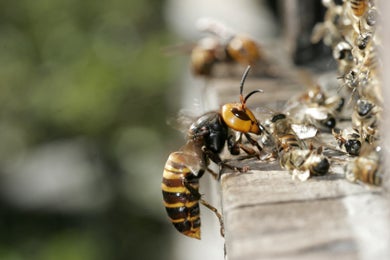Its sting is excruciating to people, but it is a bigger threat to honeybees vital for agriculture
By Paige Embry on May 6, 2020

The Asian giant hornet (Vespa mandarinia) has arrived in North America. In the past several days photographs and videos have surfaced showing how viciously this insect has attacked honeybees: it crawls into hives and rips off the heads of bees in large numbers–making its supervillain nickname, “murder hornet,” feel disturbingly apt. Government agencies and local beekeepers have sprung into action, hoping to eradicate the hornet before it can consolidate a foothold in the continent. Success may lie in how predator and prey interact naturally.
V. mandarinia is the largest hornet in the world. A female worker may grow to a length of nearly four centimeters (an inch and a half), and the insect has large biting mouthparts that enable it to decapitate its victims. Hornets are usually solitary hunters. But between late summer and fall, V. mandarinia workers may band together to conduct mass attacks on nests of other social insects, notably honeybees. This behavior even has a name: the slaughter and occupation phase. U.S. beekeepers supply billions of honeybees each year to help pollinate at least 90 agricultural crops. And they are worried that this new raider could further worsen already deep losses in important pollinator populations.
The hornet is native to Asia, ranging from Japan and Russia down to Thailand and Myanmar (formerly Burma). The first confirmed U.S. sighting was a dead specimen in Washington State last December. But several of the insects had previously been seen on nearby Vancouver Island in British Columbia in the late summer and fall of 2019. No one yet knows whether the hornet is establishing a North American beachhead in the Pacific Northwest or if it will spread from there. If it does advance, that could mean trouble.
Early colonists brought the iconic honeybee (Apis mellifera) to North America from Europe. It contributes an estimate $15 billion each year to the U.S. economy through its pollination services, far more than any other managed bee. Asia is home to a handful of other Apis species, including Apis cerana, the Asian honeybee. In parts of that continent, A. cerana is managed for pollination alongside A. mellifera. And it seems that the Asian variety has much better defenses against V. mandarinia‘s slaughter-and-occupy efforts.
All V. mandarinia workers are female. After one finds a likely target bee colony she places a pheromonal mark on it that says, “Sister, come help me get the goodies here.” When this scent is placed on an Asian honeybee hive, the bees all hunker down indoors. If a hornet gets into the nest, nearly 400 worker bees will quickly surround it, forming a ball of buzzing insects. They vibrate their flight muscles, raising the temperature to 45.9 degrees Celsius. Carbon dioxide levels also go up within the ball. The bees can handle the harsh conditions, but the hornet dies. If enough hornets respond to the pheromonal call, however, they can overwhelm the bee defenses. When they are done, the hornets have a food bank–immature bees still in their little waxen cells–which provides and excellent protein source for their own young larvae.
Unlike their Asian kind, European honeybees do not respond to the scent marker or form bee balls; they are at the mercy of V. mandarinia unless humans step in. Beekeepers can help by installing entrance traps over the doorways of managed hives that have holes large enough for a bee to pass through but not a hornet. Beekeepers may also put out baited traps to lure the hornets to their death. “Beekeepers in Asia do use entrance traps,” says Jeff Pettis, former research leader at the U.S. Department of Agriculture’s bee lab in Beltsville, Md. “Additionally, labor is often cheap, so some use mechanical means–most often tennis rackets, really–to swat the large hornets as they come to the hives.”
Another potential U.S. defense that is not available now is increasing the genetic diversity of managed honeybees. At least 29 subspecies of honeybees live naturally in Eurasia and northern Africa. Most U.S. bees are descended from the Italian subspecies, noted for its gentleness and honey-making ability–and, regrettably, its lack of resistance to some common honeybee problems. Brandon Kingsley Hopkins of Washington State University says that problems such as V. mandarinia show why countries should be preserving genetic diversity in European honeybees, because some subspecies have the ability to create bee balls.